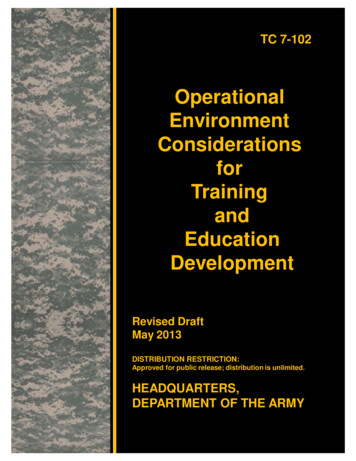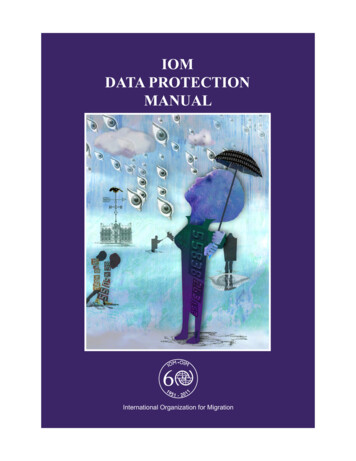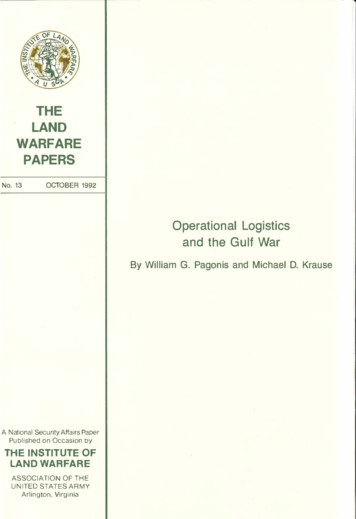
Transcription
TC ngandEducationDevelopmentRevised DraftMay 2013DISTRIBUTION RESTRICTION:Approved for public release; distribution is unlimited.HEADQUARTERS,DEPARTMENT OF THE ARMY
TC 7-102HeadquartersDepartment of the ArmyWashington, DC, May 2013Training CircularNo. 7-102Operational Environment Considerations forTraining and Education DevelopmentContentsPagePREFACE.viINTRODUCTION .viiiChapter 121ST Century Operational Environment . 1-1Chapter 2The ADDIE Process . 2-1Section I - Analysis . 2-1Section II - Design . 2-4Section III Development . 2-10Section IV Implementation. 2-15Section V - Evaluation . 2-22Non-Linear ADDIE Efficiences . 2-22Chapter 3Exercise Design Sequence . 32-1Section I - Phase 1: Initial Planning . 2-1Tools . 3-2Key Decisions . 2-4Products. 3-4Section II - Task and Countertask Development . 2-4Who . 2-7Tools . 2-9Key Decisions . 3-5Products. 3-11Section III - Phase 3: PMESII-PT Operational Environment Development 3-11Tools . 3-12Key Decisions . 3-16Products. 3-22Section IV - Phase 4: Orders, Plans, and Instruction Development . 3-22Tools . 3-23Key Decisions . 3-23Products. 3-24Section V - Summary. 3-27Distribution Restriction: Approved for public release; distribution is unlimited.i
ContentsChapter 4OPERATIONAL VARIABLES . 4-1Operational Environment . 4-1Variables, Subvariables, and Settings . 4-1Political Variable. 4-2Military Variable. 4-6Economic Variable . 4-12Social Variable . 4-15Information Variable . 4-20Infrastructure Variable . 4-26Physical Environment Variable . 4-31Time Variable . 4-42Appendix ASTAFF AND FACULTY JOB AID . A-1Appendix BEXERCISE DESIGN CHECKLIST . A-1Appendix COPFOR TACTICAL TASK LIST. C-1Appendix DHOME STATION TRAINING SCENARIO BLUEPRINTS . D-1GLOSSARY . Glossary-1REFERENCES. References-1FiguresFigure 1. Operational Environment Toolkit . ixFigure 1-1. Operational Environment Through 2028 . 1-1Figure 2-6. Types of role players . 2-20Figure 2-6. Non-Linear ADDIE Process . 2-24Figure 3-1. Selecting an area of operations (example) . 3-17Figure 3-2. Notional BCT METL with doctrinal supporting tasks (example) . 3-19Figure 3-3. Notional BCT METL supporting tasks adjusted for OE and WFF(example) . 3-21Figure 2-4. Example of required orders and plans . 3-24Figure 3-5. Types of role players . 3-26Figure D-1. MCO Blueprint COA sketch (example 1) . D-3Figure D-2. MCO Blueprint COA sketch (example 2) . D-4Figure D-3. MCO Blueprint COA sketch (example 3) . D-5Figure D-4. IW Blueprint COA sketch (example 1) . D-6Figure D-5. IW Blueprint COA sketch (example 2) . D-7Figure D-6. IW Blueprint COA sketch (example 3) . D-8TablesTable 1-1 21ST Century Soldier Competencies . 1-3Table 1-2 Operational Environment (OE) Learning Spectrum . 1-6Enlisted/Non-Commissioned Officer (NCO). 1-6iiTC 7-102Revised Draft 1 May 2013
ContentsTable 1-3 Operational Environment (OE) Learning Spectrum . 1-7Commissioned Officer . 1-7Table 1-4 Operational Environment (OE) Learning Spectrum . 1-8Civilian Education System (CES) . 1-8Table 2-1. Required Analysis Processes and Output . 2-1Table 2-2 Required Design Processes and Outputs . 2-5Figure 2-1 The major activities during the design phase . 2-7Table 2-3 General Learning Objective Writing Requirements . 2-8Table 2-4 Required Development Processes and Outputs . 2-10Table 2-5. “Political: Type of Government” subvariable definition, settings, andsetting definitions . 2-12Table 2-6. PMESII-PT variables and subvariables. 2-13Table 2-7. Sensory Response Table . 2-14Table 2-8 Required Implementation Processes and Outputs . 2-15Table 2-9 Faculty/Instructor requirements. 2-17Table 2-10 Required Evaluation Processes and Outputs . 2-22Table 3-1. Exercise design sequence . 3-1Table 3-2. Example training unit supporting subtasks (actions on contact) . 3-6Table 3-3. Example of training unit task (JOA missile defense). 3-7Table 3-4. Example of initial listing of OPFOR units selected for task organization . 3-8Table 3-5. Example of equipment listed in WEG tier tables . 3-10Table 3-6. Example of emerging technology trends from WEG . 3-11Table 3-7. “Political: Type of Government” subvariable definition, settings, andsetting definitions . 3-13Table 3-8. PMESII-PT variables and subvariables. 3-14Table 3-9. OE-WFF analysis matrix (example) . 3-20Table 4-1. Political variable and subvariable settings . 4-3Table 4-2. Political: attitude toward the United States . 4-3Table 4-3. Political: centers of political power . 4-4Table 4-4. Political: type of government . 4-4Table 4-5. Political: government effectiveness and legitimacy. 4-5Table 4-6. Political: influential political groups. 4-6Table 4-7. Military variable and subvariable settings . 4-7Table 4-8. Military: military forces . 4-7Table 4-9. Military: government paramilitary forces . 4-8Table 4-10. Military: non-state paramilitary forces . 4-8Table 4-10. Military: non-state paramilitary forces (continued) . 4-9Table 4-11. Military: unarmed combatants . 4-9Table 4-12. Military: nonmilitary armed combatants. 4-10Table 4-13. Military: military functions . 4-10Table 4-13. Military: military functions (continued) . 4-11Table 4-14. Economic variable and subvariable settings . 4-12Revised Draft 1 May 2013TC 7-102iii
ContentsTable 4-15. Economic: economic diversity . 4-12Table 4-15. Economic: economic diversity (continued) . 4-13Table 4-16. Economic: employment status . 4-13Table 4-17. Economic: economic activity. 4-13Table 4-18. Economic: illegal economic activity . 4-14Table 4-19. Economic: banking and finance . 4-14Table 4-20. Social variable and subvariable settings . 4-15Table 4-21. Social: demographic mix. 4-15Table 4-21. Social: demographic mix (continued) . 4-16Table 4-22. Social: social volatility . 4-16Table 4-23. Social: education level . 4-16Table 4-24. Social: ethnic diversity . 4-16Table 4-24. Social: ethnic diversity (continued) . 4-17Table 4-25. Social: religious diversity . 4-17Table 4-26. Social: population movement. 4-17Table 4-27. Social: common languages. 4-18Table 4-28. Social: criminal activity. 4-18Table 4-29. Social: human rights . 4-18Table 4-29. Social: human rights (continued) . 4-19Table 4-30. Information variable and subvariable settings . 4-20Table 4-31. Information: public communications media . 4-20Table 4-31. Information: public communications media (continued) . 4-21Table 4-32. Information: information warfare . 4-21Table 4-32. Information: information warfare (continued) . 4-22Table 4-32. Information: information warfare (continued) . 4-23Table 4-33. Information: intelligence . 4-23Table 4-33. Information: intelligence (continued) . 4-24Table 4-34. Information: information management . 4-24Table 4-34. Information: information management (continued) . 4-25Table 4-35. Infrastructure variable and subvariable settings . 4-26Table 4-36. Infrastructure: construction pattern . 4-26Table 4-36. Infrastructure: construction pattern (continued) . 4-27Table 4-37. Infrastructure: urban zones . 4-27Table 4-37. Infrastructure: urban zones (continued). 4-28Table 4-38. Infrastructure: urbanized building density . 4-29Table 4-39. Infrastructure: utilities present. 4-29Table 4-40. Infrastructure: utility level . 4-29Table 4-40. Infrastructure: utility level (continued) . 4-30Table 4-41. Infrastructure: transportation architecture. 4-30Table 4-42. Physical Environment variable and subvariable settings . 4-31ivTC 7-102Revised Draft 1 May 2013
ContentsTable 4-43. Physical Environment variable, subvariables and sub-subvariablesettings . 4-32Table 4-44. Physical environment: terrain . 4-33Table 4-44. Physical environment: terrain (continued) . 4-34Table 4-45. Terrain: landforms . 4-34Table 4-46. Terrain: vegetation . 4-35Table 4-47. Terrain: terrain complexity . 4-35Table 4-48. Terrain: mobility classification . 4-36Table 4-49. Physical environment: natural hazards . 4-37Table 4-50. Physical environment: climate. 4-38Table 4-51. Physical environment: weather . 4-39Table 4-52. Weather: precipitation . 4-40Table 4-53. Weather: high temperature—heat index . 4-40Table 4-54. Weather: low temperature—wind chill index . 4-40Table 4-55. Weather: wind . 4-41Table 4-56. Weather: visibility . 4-41Table 4-57. Weather: cloud cover . 4-42Table 4-58. Weather: relative humidity . 4-42Table 4-59. Time variable and subvariable settings . 4-43Table 4-60. Time: knowledge of the AO . 4-43Table 4-61. Time: cultural perception of time . 4-44Table 4-62. Time: key-event resolution . 4-44Table 4-63. Time: Information offset . 4-45Table 4-64. Time: tactical exploitation of time . 4-45Table 4-65. Time: key dates, time periods, or events . 4-46Table B-1. Exercise design checklist .B-1Revised Draft 1 May 2013TC 7-102v
PrefaceThis training circular (TC) outlines a methodology for the incorporation of the Operational Environment to support training, education and leader development. It is applicable for use at the individual level as well collectivelevel for Home Station Training. It describes training development procedures and methodologies, responsibilities, and analysis for those who develop lesson plans, training support packages, as well as those who plan andcontrol Army situational training exercises or “lane training” exercises intended as a culminating or capstonetraining event that critically assess unit-training status. Collective training is part of unit training. It is performance oriented and a command responsibility executed by leaders at all echelons. As a continuous process executed in accordance with a formal training program, collective training trains units and teams on tasks and missions they are expected to perform. It is executed in a crawl-walk-run approach and reaches across all trainingdomains and integrated live, virtual, constructive, and gaming training environments.This publication applies to the Active Army, the Army National Guard (ARNG)/Army National Guard of theUnited States (ARNGUS), and the United States Army Reserve (USAR) unless otherwise stated.Headquarters, U.S. Army Training and Doctrine Command (TRADOC) is the proponent for this TC. The preparing agency is the Contemporary Operational Environment and Threat Integration Directorate (CTID),TRADOC G-2 Intelligence Support Activity (TRISA)–Threats. Send comments and suggested improvementson DA Form 2028 (Recommended Changes to Publications and Blank Forms) directly to CTID at the followingaddress: Director, CTID, TRADOC G-2 Intelligence Support Activity–Threats, ATTN: ATIN-T (Bldg 467),803 Harrison Drive, Fort Leavenworth, KS 66027-1323.Readers should monitor those sites and also the TRADOC G2-TRISA Website at:https://www.us.army.mil/suite/files/30837459 (AKO access required) for the status of this TC and informationregarding updates. Periodic updates, subject to the normal approval process, will occur as a result of the normalproduction cycle. The date on the cover and title page of the electronic version will reflect the latest update.Revised Draft 1 May 2013TC 7-102vi
ContentsRevised Draft 1 May 2013TC 7-102vii
Introduction“If you are planning for a year, sow rice. If you are planning for a decade, plant trees. If you areplanning for a lifetime, educate a person.”Chinese ProverbThis training circular (TC) outlines a methodology for the incorporation of an Operational Environment (OE) tosupport institutional, lane training, and Home Station Training. It describes training development proceduresand methodologies, responsibilities, and analysis for those who develop lesson plans, training support packages,as well as those who plan and control Army situational training exercises or “lane training” exercises intendedas a culminating or capstone training event that critically assess unit-training status. The objective of exercisedesign is to structure a training event that establishes the conditions to facilitate performance-oriented trainingon properly selected, directed, and mission essential training objectives.The references section of this TC contains a listing of publications pertaining and relating to this publication.The glossary contains abbreviations and special terms used in this TC.This TC is a planning and design tool that significantly enhances a training developer or an exercise planner’sability to produce training and educational documentation incorporating an operational environment (OE) thatachieves desired learning or unit training objectives. This TC provides the training developer and exercise planner with a backbone methodology for scenario development and establishment of the exercise OE. The approach to exercise design and analysis is sequential and structured to get the planner to the “bottom-line” asquickly as possible.Figure 1 shows the OE tools necessary and available for the design of various training and education productsas well as a training exercise. While the process is sequential, many of the steps and procedures are developedconcurrently and may overlap (see chapter 2). This TC is meant to be used in conjunction with the 7-100 seriesas well as the other publications listed in figure 1. These tools can be found athttps://www.us.army.mil/suite/files/14705412. Together, these tools outline conditions and Hybrid Threats thatcan cover the full range of military and paramilitary capabilities against which the Army must train to ensuresuccess in the types of OEs it can expect to encounter now and in the clearly foreseeable future.Revised Draft 1 May 2013TC 7-102viii
IntroductionTC nalEnvironmentAssessment Actual OE (such asIran, North Korea, orAfghanistan) Notional or CompositeOETC 7-100 Series Responsibilities Ground (Vol I) Air & Air Defense (Vol II) Exercise Design Sequence Detailed OE Variable Settings Naval (Vol III) OPFOR Tactical Task List Strategy Operations Tactics Organization Irregular ForcesOperationalEnvironmentActor & RolePlayer HandbookTOOL BOXESFigure 1. Operational Environment ToolkitThe processes described in this TC are applicable to any number of exercise venues to include practical exercises (classroom use), field training exercises, command post exercises, situational training exercises (STX), andsimulations. They can also be used in the development of mission rehearsal exercises (MRXs). The operationalvariables (political, military, economic, social, information, infrastructure, physical environment, and time[PMESII-PT]) and the settings for their subvariables, as described in chapter 3, can be used to develop OEs forexercises or for describing actual OEs portrayed in MRXs.Each chapter of the TC covers a specific aspect of training development and exercise design. The training developer and exercise planner should become familiar with each chapter.In order to train against a realistic threat and in a realistic OE, the OE must be dynamic. By using the PMESIIPT variables and incorporating them into every aspect of the scenario, students and/or the training unit will experience a realistic and challenging exercise every time. This TC describes the roles and responsibilities of thestaff and faculty, senior trainer, exercise director, and exercise planner; the importance of quality training objectives, the steps to designing an exercise; and the theory behind exercise design. The bottom line is that this TCgives planners the tools to provide the correct exercise conditions for student and/or the training unit’s trainingobjectives, resulting in effective training and education.Revised Draft 1 May 2013TC 7-102ix
Chapter 121ST Century Operational EnvironmentSetting the Stage“The training and education of our entire force must aim to develop the mindset and requisiteknowledge, skills, and abilities required to operate effectively under the conditions of uncertainty andcomplexity.”TRADOC Pam 525-3-0The nature of the global operational environment in the 21st century can be characterized as one of uncertainty and unpredictability. However, one thing is certain: conflicts between and among civilizations, regions, nations, and groups will continue. Opponents will seek to redefine the environment andcreate advantageous asymmetrical conditions by changing the nature of the conflict and moving to employ capabilities for which future Army forces are least prepared. Furthermore, adversaries will attempt to disrupt U.S. sanctuary at home or within the region.In this context, the character of the various threats is constantly evolving, setting the stage for theemergence of the operational paradigm as illustrated in figure 1. This paradigm will consist of conditions of complexity, volatility, uncertainty, instability, and ambiguity with and among other cultures.This paradigm also suggests America’s foes will operate in complex terrain and urban environments tolessen U.S. standoff and long-range precision fires; they realize the majority of the world’s populationis increasingly concentrated in urban areas of political, economic, and social power. In addition, U.S.adversaries will attempt to deny or limit regional access, attack U.S. information systems, and dictatethe tempo of the changing environment.1-1. The Army faces a training challenge: determining how best to train its Soldiers, leaders, civilians,and units for military actions in the 21st century. Army training, education, and leader development programs and initiatives must prepare Soldiers, leaders, civilians, and units to adapt to complex situationsacross the full spectrum of operations rapidly, to fight when necessary, and to win decisively. To do this,Army forces must have the mental and physical agility to move between stability or support operations tooffensive and defensive operations when conducting wide area security and combined arms maneuver missions. They must do this while demonstrating the tactical agility to task-organize on the move while operating with and among other cultures.Figure 1-1. Op
This publication applies to the Active Army, the Army National Guard (ARNG)/Army National Guard of the United States (ARNGUS), and the United States Army Reserve (USAR) unless otherwise stated. Headquarters, U.S. Army Training and Doctrine Command (TRADOC) is the proponent for this TC. The pre-











